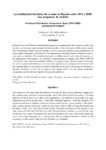Mostrar o rexistro simple do ítem
La distribución funcional de la renta en España entre 1914 y 1959: una propuesta de análisis
| dc.contributor.author | Vilar Rodríguez, Margarita | |
| dc.date.accessioned | 2020-09-22T16:29:49Z | |
| dc.date.available | 2020-09-22T16:29:49Z | |
| dc.date.issued | 2006 | |
| dc.identifier.citation | Vilar Rodríguez, M. (2006). La distribución funcional de la renta en España entre 1914 y 1959: Una propuesta de análisis. Investigaciones de Historia Económica, 2(6), 105-136. https://doi.org/10.1016/S1698-6989(06)70269-7 | es_ES |
| dc.identifier.issn | 1698-6989 | |
| dc.identifier.uri | http://hdl.handle.net/2183/26228 | |
| dc.description.abstract | [Resumen] El análisis de la distribución funcional del ingreso en España desde una perspectiva histórica ha sido un tema muy espinoso para la historiografía debido a las graves deficiencias estadísticas. El principal objetivo de este trabajo es ofrecer una nueva herramienta cuantitativa con la que poder contrastar empíricamente los argumentos sostenidos hasta el momento con escaso apoyo estadístico. El indicador propuesto se define como la ratio entre los ingresos de los trabajadores industriales y los beneficios empresariales en España entre 1914 y 1959. Su evolución a largo plazo ha permitido establecer, en primer lugar, algunos matices interesantes sobre las pautas distributivas en la economía española antes y después de la Guerra Civil. En segundo lugar, la evidencia cuantitativa obtenida revela que en la posguerra la baraja se decantó claramente a favor de los ingresos del capital frente a los del trabajo asalariado, rompiendo con la tendencia vigente en el período prebélico. [Abstract] The analysis of the functional distribution of income in Spain from a historical perspective has created many obstacles to historiography due to the lack of statistical sources. The main objective of this research is to offer a new quantitative tool which lets empirically test many arguments sustained in this field —with little statistical support— until this moment. The proposed indicator is defined as the ratio between the income corresponding to the industrial workers and the enterprise profits in Spain from 1914 to 1959. Its long‐term behaviour identifies, firstly, some interesting trends on the distributive guidelines in the Spanish economy before and after the Civil War. Secondly, the quantitative evidence reveals that the capital income was clearly favoured in the post‐War period at the same time as the labour income was clearly damaged. As a consequence, the prevailing distributive pattern in this economy over the course of the pre‐War decades was modified. | es_ES |
| dc.language.iso | spa | es_ES |
| dc.publisher | Asociación Española de Historia Económica | es_ES |
| dc.relation.uri | https://www.sciencedirect.com/science/article/abs/pii/S1698698906702697 | es_ES |
| dc.rights | Atribución-NoComercial-NoCompartir 4.0 Internacional | |
| dc.rights.uri | http://creativecommons.org/licenses/by-nc-nd/4.0/ | |
| dc.subject | Income distribution | es_ES |
| dc.subject | Wages | es_ES |
| dc.subject | Profits | es_ES |
| dc.subject | Francoism | es_ES |
| dc.subject | Spanish economy | es_ES |
| dc.subject | 20th century | es_ES |
| dc.subject | Salarios | es_ES |
| dc.subject | Franquismo | es_ES |
| dc.subject | Economía española | es_ES |
| dc.subject | Beneficios | es_ES |
| dc.subject | Siglo XX | es_ES |
| dc.subject | Distribución renta | es_ES |
| dc.title | La distribución funcional de la renta en España entre 1914 y 1959: una propuesta de análisis | es_ES |
| dc.title.alternative | Functional Distribution of Income in Spain (1914-1959): a proposal of analysis | es_ES |
| dc.type | info:eu-repo/semantics/article | es_ES |
| dc.rights.access | info:eu-repo/semantics/openAccess | es_ES |
| UDC.journalTitle | Investigaciones de Historia Económica | es_ES |
| UDC.volume | 2 | es_ES |
| UDC.issue | 6 | es_ES |
| UDC.startPage | 105 | es_ES |
| UDC.endPage | 136 | es_ES |
| dc.identifier.doi | https://doi.org/10.1016/S1698-6989(06)70269-7 |
Ficheiros no ítem
Este ítem aparece na(s) seguinte(s) colección(s)
-
GI-GEHE - Artigos [118]






